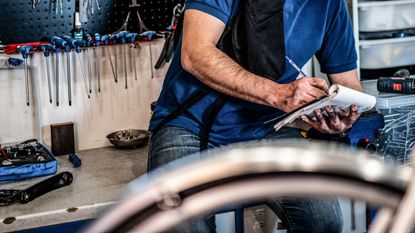Undercover mechanic: The cost of hidden cables is poor quality control, cheap components and astronomical maintenance fees
In our new series, the nameless fettler starts out with the modern bike mechanic’s most prolific bugbear


I’ve got a simple question for you: what is so offensive about cables that they’ve been banished from view on almost every mass produced bike within the ‘performance’ category?
Any of us over the age of 10 will have ridden bikes with visible cables and for the last hundred years or so they haven’t caused any problems. On the flipside, handlebars and headsets which house cables in their entirety have been on the scene for just a few years, and we’re already seeing some brands adding apparently useful ‘features’ - backed up by marketing spiel - which in reality largely exist to allow the bike to fit into the same size box as a conventional cockpit bike, and therefore facilitate delivery.

Cycling Weekly's Undercover Mechanic will be publishing his thoughts on the state of the industry once a month. He's been working with bikes for over two decades, offering servicing on models from some of cycling's best (and worst) marques. You'll find him at all major trade shows and events, just don't expect him to make himself known.
The truth of the matter is that hiding cables can offer an aerodynamic advantage if you do most of your riding at over 20mph (although it's not that much faster than shaving your legs and a lot more expensive than a Bic razor) and can - in the eyes of some - look better. That’s where the advantages stop.
The disadvantages? One: a bike without a cable in sight takes longer to build, which leads to other costs having to be cut at the factory, such as the amount of quality control exercised. Two: cost savings are also made on hidden components - such as bearings. Three: if you want any adjustments made or require replacements, it’ll cost you a bomb.
Regarding what goes on at the factory (and, I should know, I've spent enough years in and out of factories from the Far East to Eastern Europe): prices are being squeezed, the cost of any extra labour required comes from the quality of components, or the amount of quality control exercised during the build.
A drop in quality control means that a higher level of manufacturing or build defects will slip through the net and have to be dealt with at the retailer or consumer end. Ultimately, the result is that the shiny, apparently more aesthetically pleasing cable free bike could be less reliable and may not last as long as a similarly priced bike with cables for all to see.
Most integrated cockpits seem to almost relish in fitting the lowest quality bearings
On a similar note, your average carbon frame and fork these days has quite a large gap between the bottom of the headtube and the crown of the fork, unlike a good old aluminium headset cup and crown race. It's expensive to make this tolerance smaller so they can't have any seals installed between the crown and headtube. That means you are totally relying on the seals on the headset bearing.
A good quality bearing, like something from Enduro, would be fine because they have dual labyrinth seals and are packed with good quality grease. Don’t ask me why, but for some reason, most integrated cockpits - especially those that run brake hoses through their headset bearings - seem to almost relish in fitting the lowest quality bearings with a light grease or oil in them and essentially non contact seals. The result is that they need replacing annually, if not sooner. And, of course, the labour costs are astronomically higher, resulting in customers with sore wallets after less than a year of ownership.
Case in point: we had a client in earlier this year whose six month old bike needed a new lower and upper headset bearing. On their own, this would have set him back £60. But the bill was actually £250, because fitting them required us removing and replacing both brake hoses along with removing the cranks and bottom bracket to facilitate this. Understandably, he asked us if we could speak to the manufacturer to claim some of this back under his warranty which we duly did. The manufacturer pointed out that on their T&C’s they only warranty manufacturing defects and not wear and tear, which the worn-out bearings came under.
This scenario crops up pretty regularly these days, and it’s difficult to know where to put your sympathies. On one hand, the manufacturer of this type of bike surely has a duty of care to design in such a way so as to make their products fit for purpose. However, I think most of these companies would argue that their designs are fit for purpose, in that they’ve made a high-performance racing bicycle akin to a Formula One car. These require lots of careful maintenance to keep them running at optimum.
Finally, speak to any bike fitter, and they’ll no doubt chime in with a hatred of almost all formations of integrated cockpit. If you can get them to stop ranting about it for more than a few seconds you might ask them how much extra cost the cable-free aesthetic incurs - and they’ll quote something along the lines of as little as £40 to swap a stem on a conventional front end, vs £1000 for the parts and labour required to swap out an integrated cockpit.
There has become a disconnect between what a cyclist wants vs what they actually need
The advantages are minor. The disadvantages are huge. So, how have we got so far down this path? If you ask me, a lot of newer cyclists see 'new' and equate it to 'better', resulting in a disconnect between what a cyclist wants vs what they actually need; I think that is the crux of the problem.
My point is not that you shouldn’t buy a cool looking integrated cockpit aero bike if you want one. But, if you are going to make that purchase, you should only do so if you’re fully aware of what it means for you, and your future maintenance budget. Oh and ensure you have had a bike fit first so that you can get the cockpit right from the outset.
Not all integrated cockpits are made equal, either. Some brands have devised clever solutions such as Specialized with the SL7 and ENVE with the Melee, both of which integrate the cables but with separate bars and stems to allow easier and cheaper customisation and the cable routing on both of these bikes is very simple. On the other hand there are some brands that should be genuinely ashamed. If you are in any way unsure, seek out a good local mechanic or bike fitter, as they will have experience of the wide array of solutions out there and be able to advise you on the good ones and the ones to avoid. Just beware if you notice they have a spoiler fitted to their Fiesta.

Thank you for reading 20 articles this month* Join now for unlimited access
Enjoy your first month for just £1 / $1 / €1
*Read 5 free articles per month without a subscription

Join now for unlimited access
Try first month for just £1 / $1 / €1
Get The Leadout Newsletter
The latest race content, interviews, features, reviews and expert buying guides, direct to your inbox!

Cycling Weekly's Undercover Mechanic will be publishing his thoughts on the state of the industry once a month. He's been working with bikes for over two decades, offering servicing on models from some of cycling's best (and worst) marques. You'll find him at all major trade shows and events, just don't expect him to make himself known.
-
 A break up letter to... Strava
A break up letter to... StravaIt's not you, it's me. But, some of it is you.
By Michelle Arthurs-Brennan Published
-
 I completed this 12-week strength training program for cyclists and here's how it improved my peak power
I completed this 12-week strength training program for cyclists and here's how it improved my peak powerFrom five second sprints to 20 minute FTP tests, I saw significant gains across the board
By Andy Turner Published

